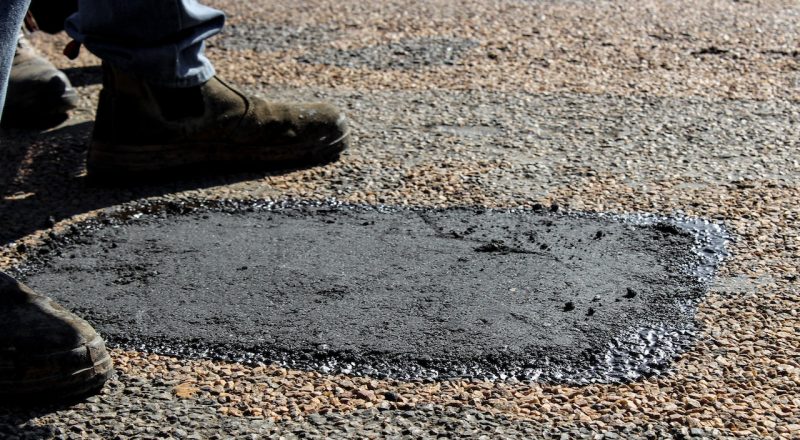An asphalt driveway is a durable and cost-effective option for homeowners. Over time, though, wear and tear may cause cracks and potholes to form. Ignoring these issues can lead to more extensive damage and costly repairs. Fortunately, patching your asphalt driveway is a relatively simple process that can restore its appearance and functionality.
In this comprehensive guide, we will walk you through the step-by-step process of how to patch an asphalt driveway, ensuring that you can tackle this task with confidence and maintain the longevity of your driveway.
Assess The Damage
Before diving into the patching process, it’s crucial to assess the extent of the damage on your asphalt driveway. Walk along the surface and examine any visible cracks, potholes, or depressions. Pay special attention to areas where water has pooled or where vegetation is growing, as these are common signs of underlying issues.
Gather The Necessary Tools And Materials For Asphalt Driveway Repair

To successfully patch an asphalt driveway, you’ll need the following tools and materials:
- Safety gear: Gloves, safety glasses, and a dust mask.
- Cleaning equipment: Broom, pressure washer, and a stiff-bristle brush.
- Asphalt patching material: Cold patch asphalt mix or hot asphalt mix, depending on the scale of the repair.
- Tamper: A heavy-duty tamper or a hand tamper for compacting the patch.
- Edging tool: To create clean edges around the patch.
- Sealant: Optional, but recommended for a finished look and added protection.
Prepare The Surface
Preparing the surface is a crucial step in achieving a successful asphalt patch. Follow these steps:
- Clear the area: Remove any loose debris, weeds, or grass from the damaged area using a broom or a pressure washer.
- Clean the surface: Use a stiff-bristle brush or pressure washer to thoroughly clean the area, removing any dirt, grease, or oil. This step ensures proper adhesion of the patching material.
- Fill cracks and potholes: For larger cracks and potholes, use a cold patch asphalt mix or hot asphalt mix, following the manufacturer’s instructions. Fill the cracks and potholes slightly above the surface level, as the material will compact when tamped.
- Wait for curing: Allow the filled cracks and potholes to cure according to the manufacturer’s instructions. This typically takes a few days.
Apply The Patching Material
Now that the surface is prepared, it’s time to apply the patching material. Follow these steps:
- Read the instructions: Carefully read and follow the instructions provided by the manufacturer of your chosen patching material.
- Mix the patching material: If using a cold patch asphalt mix, no mixing is required. If using a hot asphalt mix, follow the instructions for proper heating and mixing.
- Work in small sections: Apply the patching material in small sections, ensuring even coverage. Use a shovel to spread the material over the damaged area, keeping it slightly above the surrounding surface.
- Compact the material: Use a tamper to firmly compact the patching material. Start at the edges and work your way towards the center, ensuring a level and sturdy repair. Continue compacting until the material is flush with the existing driveway surface.
- Create clean edges: Use an edging tool to create clean and defined edges around the repaired area. This will give your patch a professional finish.
- Allow curing time: Depending on the type of patching material used, allow ample time for curing and drying. Follow the manufacturer’s recommendations.
Optional: Seal The Driveway
While sealing the entire driveway is not necessary after patching, it can provide additional protection and enhance the overall appearance. If you choose to seal your driveway, follow these steps:
- Select a sealant: Choose an asphalt driveway sealer that is compatible with your patching material. Read the instructions for proper application.
- Prepare the surface: Clean the entire driveway with a pressure washer, removing any dirt or debris. Allow the driveway to dry completely before applying the sealant.
- Apply the sealant: Use a brush or roller to apply the sealant evenly across the entire driveway surface. Follow the manufacturer’s instructions for drying time and reapplication if necessary.
Hiring A Professional To Do The Patching Work
If you don’t feel comfortable tackling this project yourself, you can also hire a professional to complete the patching work for you. It’s best to hire a local contractor who specializes in asphalt repairs. They will be able to assess the damage and provide an estimate for repairing your driveway. Be sure to read reviews and get references before hiring any contractor.
We recommend you to contact a company like Advanced Asphalt of SW FL in Venice FL as they have the expertise and experience to do the job correctly. They will be able to provide quality results that will make your asphalt driveway look as good as new.
Conclusion
Overall, these are the steps you need to follow when patching an asphalt driveway. With a little bit of time and effort, you can successfully restore its appearance and functionality. This simple task can add years of life to your driveway and prevent costly repairs down the road. With that in mind, it’s a great idea to check your asphalt driveway regularly for signs of damage and address any issues as soon as possible. Regular maintenance is key to ensuring a long-lasting and durable surface.



